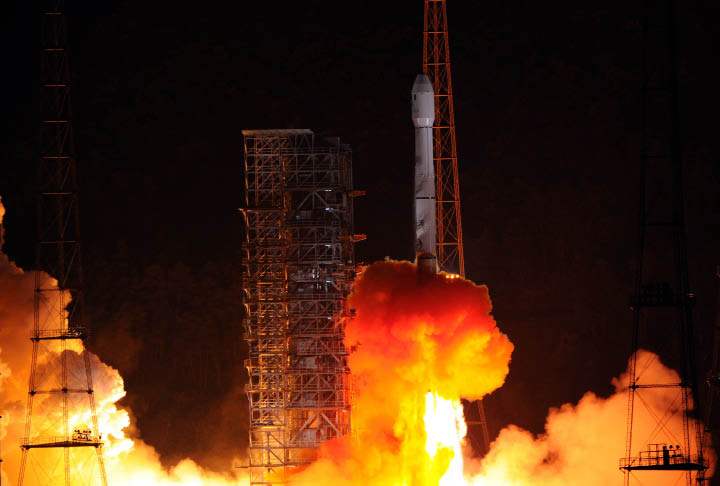China’s Indigenous Space Program
Develops in Leaps and Bounds
By staff reporter JIAO FENG
 |
| China sent a communications satellite into orbit for the Nigerian government on December 20, 2011. The carrier rocket, Long March 3-B, blasted off from Xichang Satellite Launch Center in southwest China's Sichuan Province. |
ON December 27, 2012, the Beidou Navigation Satellite System (BDS) officially started providing passive location, navigation, time lookup and other services to most parts of the Asia-Pacific region.
BDS is a global satellite positioning and communication system independently engineered and operated by China. The country is the third in the world to run its own satellite navigation system after the U.S. and Russia.
China’s aerospace science and technology industry has been advancing in leaps and bounds over the past few years. Before the launch of the BDS, the country put a space station, Tiangong 1, into orbit in September 2011. Since then two docking missions to the space station have been accomplished with the country’s own Shenzhou 8 and Shenzhou 9 spacecrafts. Shenzhou 10 is set to be launched in 2013.
The industry has been a long time in development, and the last few years are the culmination of 56 years of scientific endeavor. China has headed to space on the back of its own technology. Its first artificial satellite to orbit the Earth, its first manned space flight, its moon probe and many others were all based on indigenous scientific and engineering innovation.
Admittedly, China’s aerospace industry still lags behind those of the U.S. and Russia. Particularly when it comes to high-end components, new materials, and engine technology, China still has a long way to go.
We Come in Peace
China believes in the peaceful exploration and development of space. Tiangong 1, the first in a long line of orbiters that will build foundations for a fully-fledged modular Chinese space station, is the embodiment of China’s peaceful, science-oriented space program.
The station is in effect a laboratory, with geographic environment monitoring, space environment monitoring and space materials testing currently underway.
So far, Tiangong 1 has sent back precious test data that scientists hope will be applied to research in resource management, agriculture, forestry, oil and gas utilization, mineral extraction, the exploration of the seas, urban heat island effect analysis, atmospheric monitoring, materials science and other fields.
Zhang Bainan, chief designer of China’s spacecraft systems, said that Tiangong 1 has been operating smoothly since its launch. It is currently carrying out an array of scientific experiments, he said, and its next big mission will be a rendezvous and docking trial with Shenzhou 10. This mission is expected to verify the technology involved in the tricky maneuvers and judge the station’s assembly control techniques. Mastering docking is crucial for the future establishment and management of a long-term manned space station.
- Xi Elected Chinese President, Chairman of PRC Central Military Commission
- Li Keqiang Endorsed as Chinese Premier
- Fan Changlong, Xu Qiliang Endorsed as Vice Chairmen of Central Military Commission of PRC
- New Leadership Elected for China's Top Legislature
- Proceedings Initiated for China's Leadership Change

